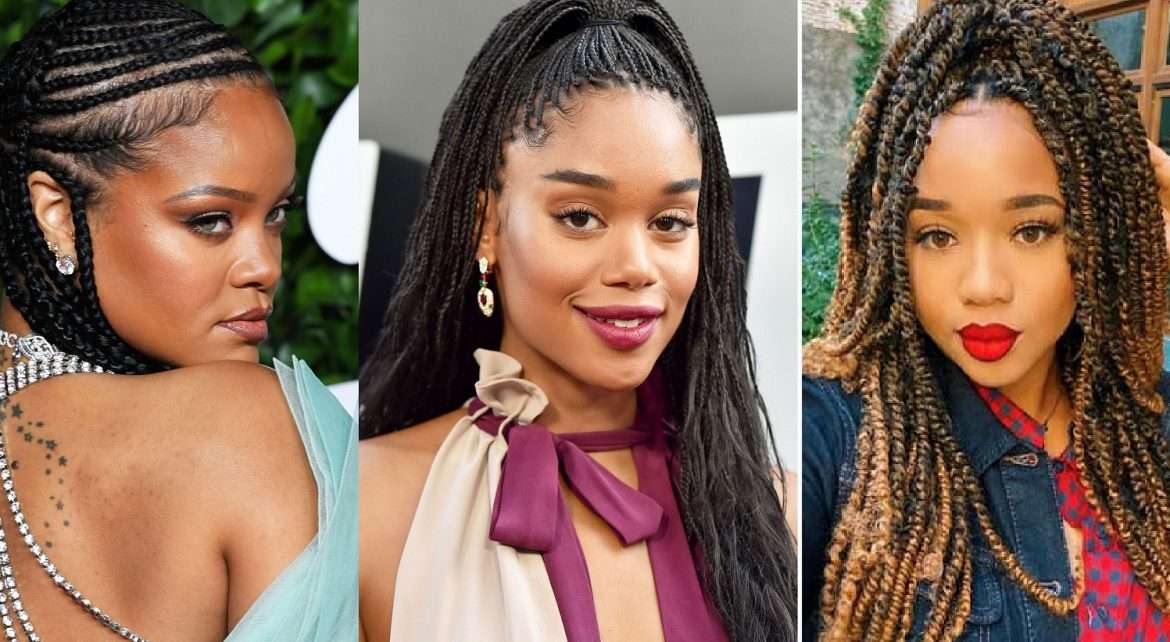Table of Contents
Embracing the Allure of Fulani Braids Styles
Fulani braids styles, also known as Fulani-inspired braids or tribal braids, have gained immense popularity in the United States and around the world. These exquisite and intricate braided hairstyles are not only visually stunning but also carry deep cultural significance.
Originating from the Fulani people, a predominantly Muslim ethnic group scattered across West Africa, Fulani braids styles have become a celebrated symbol of beauty, style, and heritage.
In this article, we will delve into the world of Fulani braids styles, exploring their diverse designs, their historical and cultural background, and answering some commonly asked questions. So, let’s embark on this enlightening journey!
Editor’s Pick: Cornrows with hair: Easy Guide & 20 Best Cornrow Hairstyles
The Artistry of Fulani Braids Styles: 50 Stunning Designs
Fulani braids styles come in a myriad of styles, each with its own unique charm. Here, we present 50 eye-catching Fulani Braids Hairstyles that highlight the versatility and creativity of Fulani braids styles. 05 Styles out of 50, we present briefly as below.
01. Classic center-parted long braids.
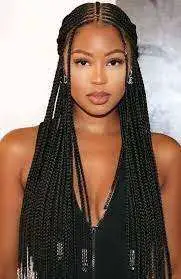
Classic center-parted long braids are a timeless and elegant hairstyle choice. They exude a sense of simplicity and sophistication while maintaining a versatile and practical appeal. Here’s a closer look at this iconic braided style:
Style Description:
Classic center-parted long braids involve dividing the hair into two equal sections down the middle of the scalp, creating a clear and symmetrical parting. Each section of hair is then tightly braided from the roots to the ends, resulting in two long and sleek braids that cascade down the back.
Key Features:
- Parting: The center parting adds symmetry to the hairstyle and frames the face beautifully.
- Length: Classic center-parted long braids work best with medium to long hair lengths, as the braids are allowed to flow down the back gracefully.
- Neatness: This style emphasizes neat and well-defined braids, with each strand tightly woven for a polished appearance.
- Versatility: Classic center-parted long braids can be styled in various ways, such as being wrapped into a bun, pulled back into a ponytail, or left loose.
Tips for Achieving Classic Center-Parted Long Braids:
- Start with clean and detangled hair to ensure a smooth and seamless braiding process.
- Use a fine-toothed comb to create a precise center parting from the forehead down to the nape of the neck.
- Divide the hair into two equal sections, securing one side with a clip or hair tie to keep it out of the way while you work on the other side.
- Begin braiding one section, incorporating small sections of hair from the root as you go along, and continue braiding until you reach the ends. Repeat the same process for the other side.
- Ensure that the tension is consistent throughout the braids to maintain a uniform appearance.
- Secure the ends of the braids with hair ties or small, discreet elastics.
- For a sleek finish, apply a light hair gel or edge control product along the hairline to smooth any flyaways and baby hairs.
Classic center-parted long braids offer a timeless and graceful look that can be embraced for various occasions, from casual outings to formal events. Their simplicity and versatility make them a go-to choice for individuals seeking a chic and polished braided hairstyle.
02. Intricate cornrows with decorative beads.
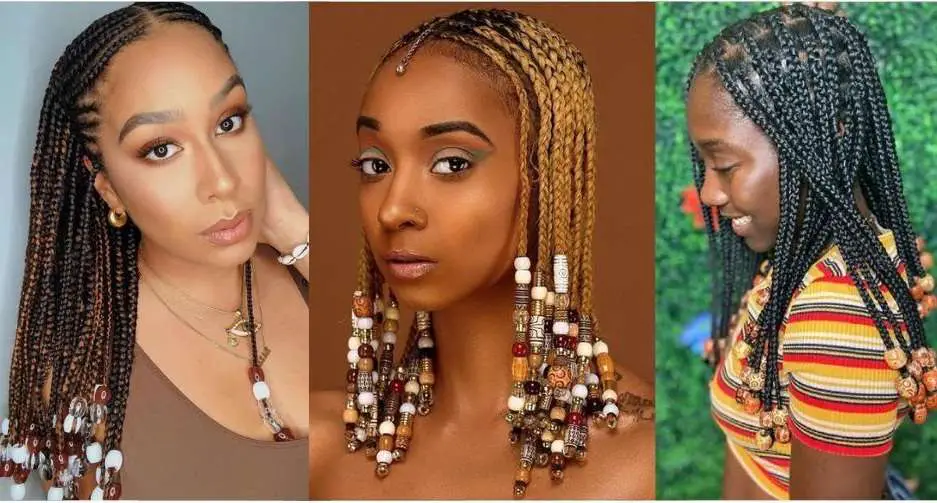
Intricate cornrows with decorative beads are a stunning and culturally rich braided hairstyle. This style involves weaving tight and intricate cornrows close to the scalp, adorned with decorative beads that add a touch of flair and personalization. Here’s a closer look at this captivating braided design:
Style Description:
Intricate cornrows with decorative beads are created by sectioning the hair into small, tight rows that are braided close to the scalp. The cornrows are crafted with intricate patterns and designs, showcasing the skill and artistry of the stylist. Decorative beads, often made of wood, plastic, or metal, are then threaded onto the braids, adding visual interest and individual style.
Key Features:
- Cornrow Patterns: Intricate cornrows feature various patterns, such as geometric shapes, zigzags, curves, or more intricate and artistic designs. These patterns can be customized to suit personal preferences and the creativity of the braider.
- Bead Embellishments: The addition of decorative beads is a distinguishing feature of this style. The beads are threaded onto the braids at intervals, creating a vibrant and eye-catching effect. Beads can be chosen in different colors, shapes, and sizes to match individual style and enhance the overall aesthetic.
- Scalp-Hugging: Cornrows are braided close to the scalp, providing a sleek and low-maintenance hairstyle that can last for several weeks with proper care.
- Versatility: Intricate cornrows with decorative beads offer versatility in styling. The beads can be arranged in various patterns or incorporated into updos, ponytails, or buns, allowing for different looks while still showcasing the intricate cornrow base.
Tips for Achieving Intricate Cornrows with Decorative Beads:
- Start with clean, moisturized hair. Use a wide-toothed comb to detangle and section the hair into the desired cornrow pattern.
- Begin by parting the hair into sections according to the desired cornrow design. Cornrows can be straight, curved, or follow a specific pattern.
- Take a small section of hair at the hairline and divide it into three equal strands to start the cornrow braid.
- Cross the right strand under the middle strand, then cross the left strand under the new middle strand. Continue this braiding technique, adding small sections of hair to each strand as you go.
- Braid tightly and close to the scalp, maintaining consistent tension to ensure neat and secure cornrows.
- Repeat the braiding process for each section, following the chosen cornrow pattern.
- Once all the cornrows are braided, add decorative beads by threading them onto the braids. You can incorporate beads at regular intervals or create specific bead patterns to enhance the overall design.
- Secure the ends of the cornrows with small hair ties or tuck them under adjacent cornrows for a clean finish.
Intricate cornrows with decorative beads showcase a fusion of intricate braiding techniques and personalized adornments, creating a striking and culturally significant hairstyle. This style allows for individual expression and offers a visually captivating look that celebrates both artistry and personal style.
03. Fulani braids with thin side braids.
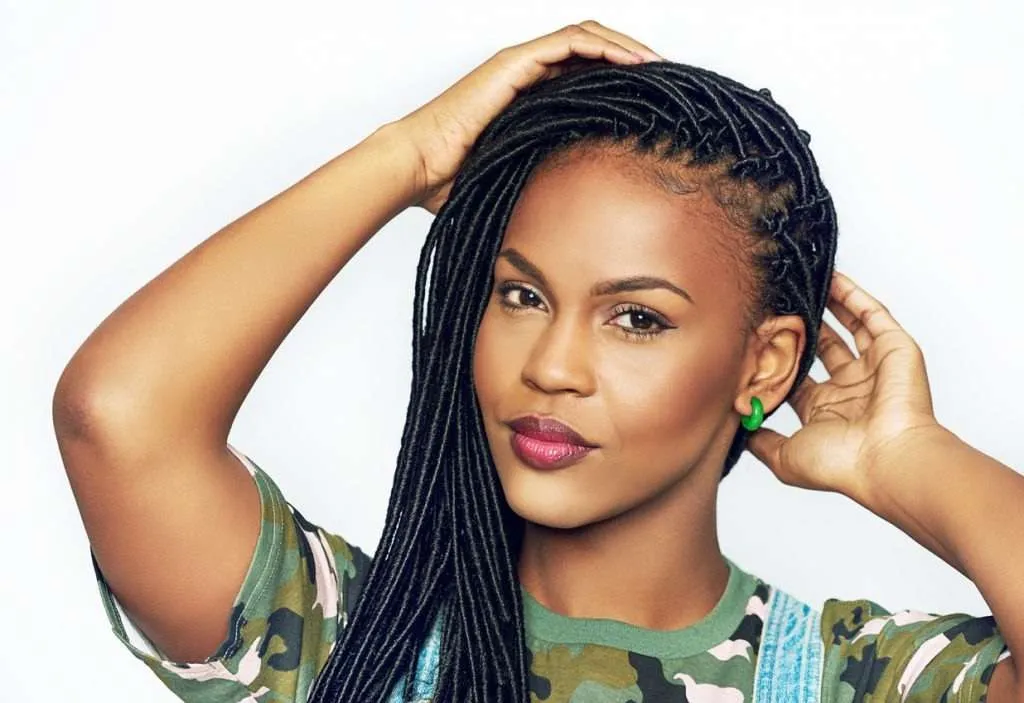
Fulani braids with thin side braids combine the elegance of Fulani braids with the added charm of delicate side braids. This style incorporates the traditional Fulani braids as the central focus while incorporating thinner braids on the sides for a touch of uniqueness. Here’s a closer look at this beautiful braided hairstyle:
Style Description:
Fulani braids with thin side braids feature the iconic Fulani braids as the main element. The hair is typically divided into sections, and the central parting creates a clear separation between the two sides.
The Fulani braids, characterized by their intricate patterns and adornments, are braided down the middle, while thin side braids are woven on each side of the head. The combination of the Fulani braids and the delicate side braids creates a stunning and eye-catching hairstyle.
Key Features:
- Central Fulani Braids: The central parting allows for the creation of classic Fulani braids in the middle. These braids are often styled in various designs, such as geometric patterns, twists, or other intricate styles, highlighting the cultural heritage of Fulani braids.
- Thin Side Braids: Thin side braids are incorporated on each side of the head, starting from the hairline and extending to a desired length. These side braids can be simple and straight or can also feature their own unique patterns or twists.
- Contrast and Balance: The combination of the thicker Fulani braids with the thinner side braids creates a visually appealing contrast and adds an element of balance to the overall hairstyle.
- Adornments: Like traditional Fulani braids, this style can be embellished with decorative elements such as beads, cowrie shells, or hair cuffs. These adornments add an extra touch of elegance and individuality to the overall look.
Tips for Achieving Fulani Braids with Thin Side Braids:
- Start with clean, detangled hair. Use a fine-toothed comb to create a clean central parting from the forehead down to the nape of the neck.
- Section off the hair on each side of the head, separating it from the central section where the Fulani braids will be placed.
- Begin by braiding the central section of hair using the chosen Fulani braiding technique. Incorporate any desired patterns or twists while braiding down the middle.
- On each side section, divide the hair into smaller subsections and create thin side braids. You can opt for simple, straight braids or add twists or intricate patterns to the side braids.
- Braid the side sections tightly and securely, ensuring consistent tension throughout.
- Once all the braids are complete, you can enhance the style by adding decorative elements such as beads, cowrie shells, or hair cuffs to both the Fulani braids and the side braids.
- To finish, secure the ends of the braids with small hair ties or tuck them under adjacent braids for a polished look.
Fulani braids with thin side braids offer a captivating twist on the classic Fulani braided style. The combination of thicker central braids and delicate side braids creates a unique and visually striking hairstyle that celebrates the artistry and cultural significance of Fulani braids while adding a touch of individuality and creativity.
04. Micro braids styled into a high bun.
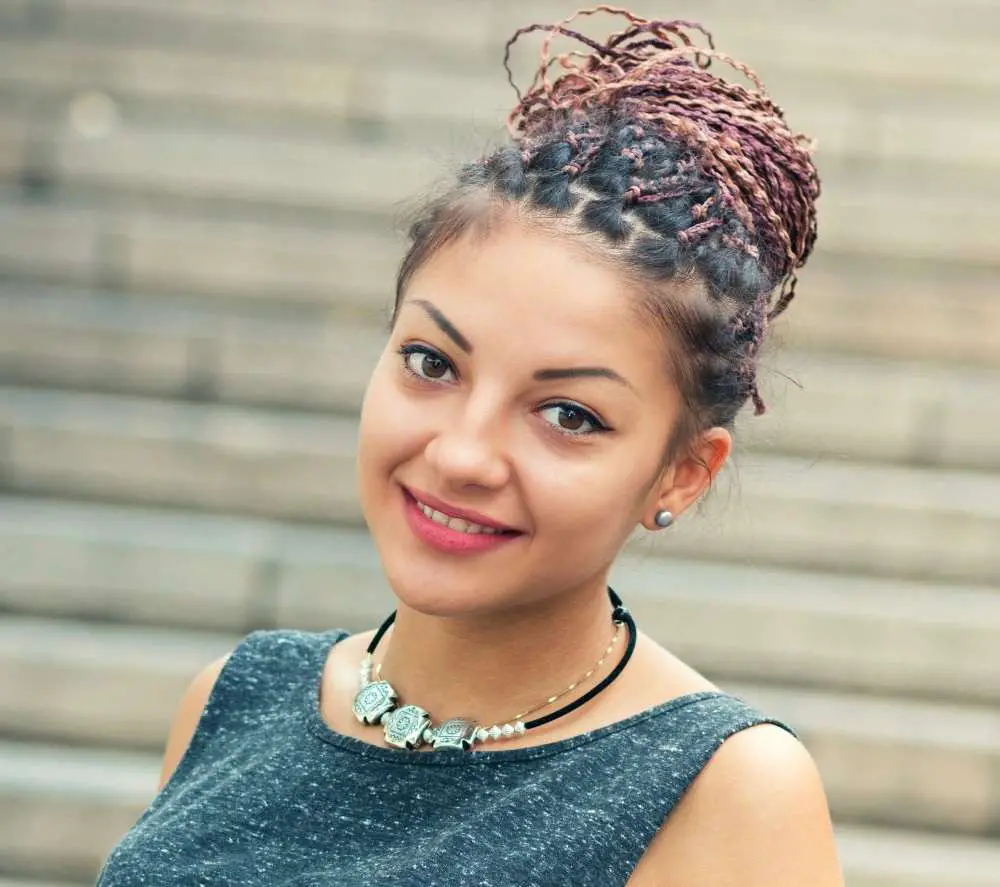
Micro braids styled into a high bun create a chic and versatile look that combines the intricacy of micro braids with the elegance of an elevated bun. This hairstyle showcases the small, tightly braided sections while providing a polished and sophisticated updo. Here’s a closer look at this trendy braided hairstyle:
Style Description:
Micro braids styled into a high bun involve braiding the hair into numerous small and thin braids that are tightly woven from the roots to the ends. Once the micro braids are completed, they are gathered and styled into a high bun positioned on top of the head. The result is a sleek and elevated bun that showcases the intricate micro braids.
Key Features:
- Micro Braids: The defining feature of this style is the use of micro braids, which are tiny and tightly woven braids. These braids require precision and attention to detail, as each section is braided with care to create the desired effect.
- High Bun: The micro braids are gathered and secured into a high bun positioned on top of the head. This elevated placement adds a touch of sophistication and ensures the braids remain the focal point of the hairstyle.
- Sleekness: The micro braids are styled to appear smooth, sleek, and well-defined. This sleekness enhances the overall polished and elegant look of the high bun.
- Versatility: While the high bun is a classic choice, this hairstyle offers versatility. The bun can be styled in various ways, such as a neat and compact bun, a twisted or braided bun, or even a voluminous and textured bun, allowing for different interpretations of the style.
Tips for Achieving Micro Braids Styled into a High Bun:
- Begin with clean, detangled hair. It is recommended to wash and condition your hair before braiding to ensure a fresh and manageable base.
- Divide the hair into small, even sections for the micro braids. The number of sections will depend on the desired thickness and volume of the braids.
- Start braiding each section from the roots, incorporating small sections of hair as you go along. Braid tightly and evenly, ensuring that each braid is consistent in size and appearance.
- Continue braiding until all sections of hair are completed with micro braids. Take your time to ensure each braid is neat and well-crafted.
- Once all the micro braids are complete, gather them together and secure them into a high ponytail positioned on top of the head.
- Twist or braid the ponytail and wrap it around the base to create a bun shape. Use hairpins or a hair tie to secure the bun in place.
- Ensure that the micro braids are neatly tucked into the bun, creating a seamless and polished look.
- Finish the style with a light hairspray or styling gel to keep any flyaways in check and add a sleek and polished finish.
Micro braids styled into a high bun offer a modern and sophisticated take on braided hairstyles. This combination allows you to showcase the intricacy of micro braids while creating an elevated and polished updo. Whether for a special occasion or a chic everyday look, this hairstyle is sure to turn heads and make a statement.
05. Fulani braids with long extensions.
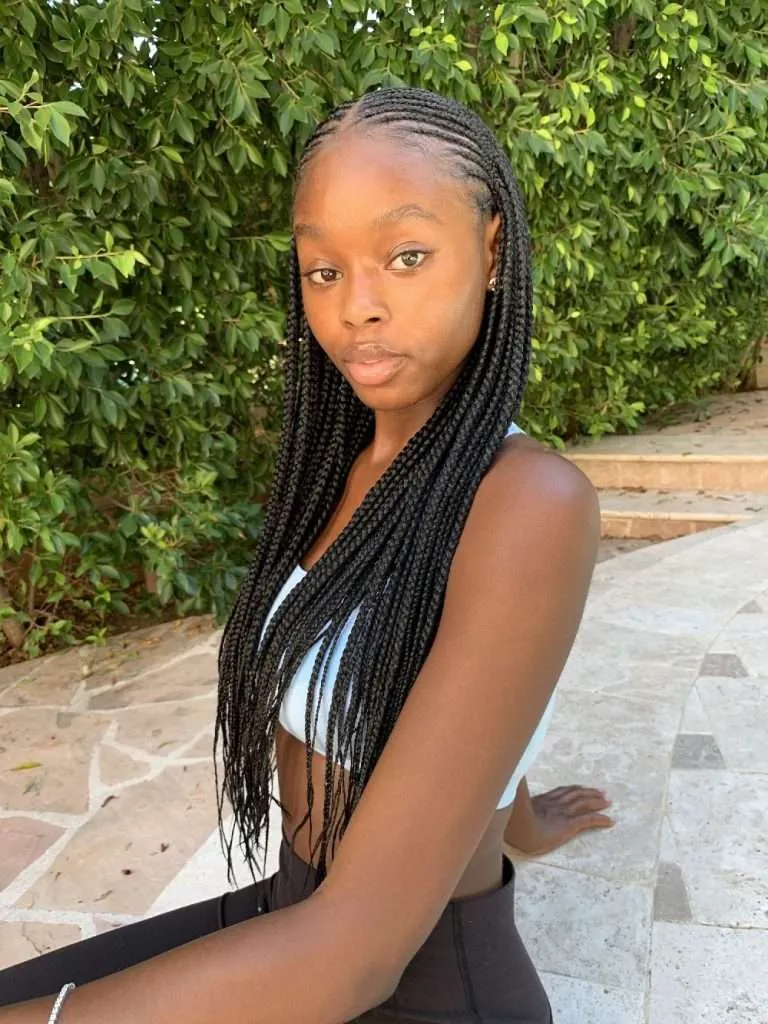
Fulani braids with long extensions create a stunning and dramatic look by combining the traditional Fulani braiding style with added length and volume. This style allows for versatility in styling while maintaining the essence of Fulani braids. Here’s a closer look at this captivating braided hairstyle:
Style Description:
Fulani braids with long extensions involve incorporating extensions into the natural hair to create longer and fuller braids. The central parting is created, and the hair is then divided into sections for braiding. Extensions, which can be made of synthetic or human hair, are added to each section to achieve the desired length. The braids are then intricately styled with various patterns, twists, or adornments, highlighting the cultural significance of Fulani braids.
Key Features:
- Length and Volume: The addition of long extensions provides a significant increase in length and volume, allowing for more styling options and a bold visual impact.
- Central Parting: The central parting remains a fundamental element of Fulani braids. It creates a clear division for the braids and contributes to the overall symmetry of the hairstyle.
- Intricate Braiding: Fulani braids with long extensions can be styled in various patterns, twists, or designs. These braids can be crafted with precision, incorporating cultural elements such as geometric shapes or unique adornments.
- Versatility: The length and volume offered by the extensions provide versatility in styling. The braids can be worn loose, pulled back into a ponytail, or styled into updos or buns, allowing for different looks while maintaining the essence of the Fulani braided style.
Tips for Achieving Fulani Braids with Long Extensions:
- Start with clean and detangled hair. Extensions adhere better to clean hair, and detangling ensures a smooth braiding process.
- Create a clean central parting from the forehead down to the nape of the neck using a fine-toothed comb.
- Divide the hair into sections, ensuring that each section is not too thick to allow for proper braiding and secure attachment of the extensions.
- Attach the extensions to each section of hair. This can be done using various methods such as braiding the natural hair with the extension hair or using hair glue or clips.
- Begin braiding each section, incorporating the extensions into the braids as you go along. Pay attention to the desired pattern or design, ensuring the braids are tightly woven and secure.
- Repeat the braiding process for each section, ensuring consistent tension and uniformity throughout.
- Style the braids as desired, whether it’s wearing them loose, gathering them into a ponytail, or creating an intricate updo.
- Enhance the braids with adornments such as beads, cowrie shells, or hair cuffs to add cultural and personal flair.
- To maintain the style, regularly moisturize the scalp and braids, and avoid excessive pulling or tension on the braids.
Fulani braids with long extensions offer a bold and captivating hairstyle that celebrates the artistry and cultural heritage of Fulani braids while providing added length and versatility. This style allows for personal expression and creativity, enabling individuals to embrace a unique and stunning braided look.
You can find the rest of 45 Fulani Braids styles here:
- Zigzag partings with thin braids.
- Fulani braids adorned with cowrie shells.
- Large, chunky Fulani braids.
- Side-swept braids with beaded ends.
- Fulani braids with top knot bun.
- Braided crown with hanging braids.
- Half-up, half-down Fulani braids.
- Fulani braids with colorful yarn accents.
- Thick Fulani braids in a ponytail.
- Braided bob with Fulani-inspired patterns.
- Fulani braids with golden hair cuffs.
- Diagonal partings with medium-sized braids.
- Fulani braids with feather accessories.
- Braided updo with intricate patterns.
- Fulani braids with wooden bead embellishments.
- Tapered Fulani braids with shaved sides.
- Fulani braids with side-swept bangs.
- Goddess braids inspired by Fulani style.
- Fulani braids with geometric designs.
- Braided headband with loose curls.
- Fulani braids with colorful ribbon accents.
- Braided Mohawk with Fulani-inspired braids.
- Fulani braids with twisted or braided edges.
- Bantu knots with Fulani braided details.
- Fulani braids with wrap-around braided ponytail.
- Side-parted Fulani braids with intricate patterns.
- Fulani braids with mixed braid sizes.
- Fishtail braids with Fulani-inspired hairline.
- Fulani braids with cascading braided accents.
- Braided bun with Fulani-inspired side braids.
- Fulani braids with curly or wavy extensions.
- Multi-colored Fulani braids.
- Fulani braids with front braided bangs.
- Braided pigtails with Fulani-inspired braids.
- Fulani braids with tribal beadwork.
- Fulani braids with twisted rope accents.
- Fulani braids with hair rings and charms.
- Fulani braids with crisscrossed patterns.
- Fulani braids with
- Fulani braids with graduated length.
- Braided updo with Fulani-inspired side twists.
- Fulani braids with braided or twisted ponytail.
- Fulani braids with side cornrows.
- Fulani braids with hair wraps and scarves.
- Fulani braids with colorful thread embellishments.
Unveiling the Cultural Significance of Fulani Braids
Fulani braids are not merely a fashion statement; they hold deep cultural significance within the Fulani community. These braided hairstyles are often associated with beauty, femininity, and cultural heritage. Here are some key insights into the cultural importance of Fulani braids:
- Cultural Identity: Fulani braids styles are a way for Fulani people, particularly women, to express their cultural identity and pride in their heritage.
- Marriage Symbolism: In some Fulani communities, braided hairstyles play a role in traditional marriage ceremonies, representing a woman’s eligibility and readiness for marriage.
- Social Status: Elaborate and intricate braided hairstyles like Fulani braids can indicate a person’s social status or wealth within the community.
- Spiritual Beliefs: Some Fulani women believe that braiding their hair with specific patterns and adornments can provide spiritual protection and ward off negative energy.
- Passing Down Traditions: Fulani braiding techniques and styles are often passed down from older generations to younger ones, ensuring the preservation of cultural traditions.
Braids Around the World
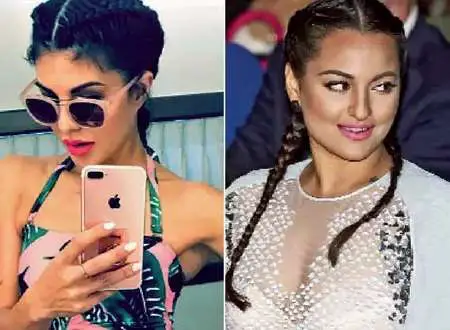
Braided hairstyles are not limited to a single culture or country. They have been embraced by various societies around the globe. Here are a few examples:
- Africa: Apart from Fulani braids styles, many other African countries have their own distinctive braiding styles, such as Ghana braids, Senegalese twists, and Ethiopian braids.
- India: Braids hold cultural significance in India and are commonly worn by women. Traditional Indian hairstyles often feature long, intricately braided hair adorned with accessories like flowers and jewels.
- China: Braids have historically been a common hairstyle choice for girls in China. They symbolize innocence, obedience, and traditional values.
- Scandinavia: In some Scandinavian countries like Norway and Sweden, braided hairstyles, particularly intricate crown braids, are part of traditional folk costumes and are worn during festive occasions.
- Native American Cultures: Native American tribes have their own distinct braiding traditions, with styles varying among tribes and regions. Braids are often decorated with feathers, beads, and other symbolic ornaments.
Conclusion
Fulani braids captivate with their intricate designs and deep-rooted cultural significance. From their origins in West Africa to their widespread popularity in the United States, these braided hairstyles embody beauty, artistry, and a connection to heritage.
By exploring the diverse designs and understanding their cultural importance, we can truly appreciate the richness and diversity of Fulani braids. So, embrace the allure of Fulani braids and let them adorn your crowning glory with their timeless elegance.
FULANI BRAIDS HAIR TUTORIAL! (Video)
Q&A – Fulani Braids Styles
Q1: What are Zendaya’s braids called?
Zendaya has been spotted wearing Fulani braids, showcasing her appreciation for this traditional African hairstyle.
Q2: What are Rihanna braids called?
Rihanna has often sported Fulani-inspired braids, adding her unique flair to this cultural hairstyle.
Q3: How long do Fulani braids styles last?
The longevity of Fulani braids depends on various factors such as hair type, maintenance, and individual hair growth. On average, they can last anywhere from two to eight weeks.
Q4: What country do Fulani braids styles come from?
Fulani braids originate from the Fulani people, who are primarily found in several countries across West Africa, including Nigeria, Senegal, Mali, Guinea, and Cameroon.
Q5: What do braids mean in Japan?
In Japan, braids are often associated with school uniforms and are considered a traditional and neat hairstyle choice, symbolizing discipline and conformity.
Q6: Why do some girls in China wear their hair in braids?
In China, braided hairstyles have a cultural significance and historical significance, particularly for girls. Traditionally, braids symbolize innocence, obedience, and adherence to traditional values.
Braided hairstyles were commonly worn by young girls as a way to signify their purity and signify their transition into womanhood. Although modern fashion trends have diversified hairstyles in China, braids continue to be seen as a traditional and neat choice for girls, especially in school settings.
Q7: Are braids an Indian thing?
Yes, braids have a significant cultural presence in India. Indian women have been adorning braided hairstyles for centuries, and it remains a popular choice even today. Braids in India are often long, intricately woven, and adorned with accessories such as flowers, ribbons, or jewels.
Braided hairstyles hold cultural and religious importance in India, with different regions and communities having their own unique styles. From the classic long braid known as “Jata” or “Sikha” in Hinduism to the elaborate bridal braids and intricate patterns seen in various Indian dance forms, braids are an integral part of Indian culture and fashion.
You may also read: How To Dye Your Hair At Home By Yourself: Comprehensive Guide
